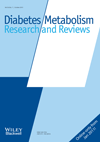Vibration perception threshold for sight-threatening retinopathy screening in type 2 diabetic outpatients
Abstract
Objective
We investigated the relationship between vibration perception threshold and diabetic retinopathy and verified the screening value of vibration perception threshold for severe diabetic retinopathy.
Methods
A total of 955 patients with type 2 diabetes were recruited and divided into three groups according to their fundus oculi photography results: no diabetic retinopathy (n = 654, 68.48%), non-sight-threatening diabetic retinopathy (n = 189, 19.79%) and sight-threatening diabetic retinopathy (n = 112, 11.73%). Their clinical and biochemical characteristics, vibration perception threshold and the diabetic retinopathy grades were detected and compared.
Results
There were significant differences in diabetes duration and blood glucose levels among three groups (all p < 0.05). The values of vibration perception threshold increased with the rising severity of retinopathy, and the vibration perception threshold level of sight-threatening diabetic retinopathy group was significantly higher than both non-sight-threatening diabetic retinopathy and no diabetic retinopathy groups (both p < 0.01). The prevalence of sight-threatening diabetic retinopathy in vibration perception threshold >25 V group was significantly higher than those in 16–24 V group (p < 0.01). The severity of diabetic retinopathy was positively associated with diabetes duration, blood glucose indexes and vibration perception threshold (all p < 0.01). Multiple stepwise regression analysis proved that glycosylated haemoglobin (β = 0.385, p = 0.000), diabetes duration (β = 0.275, p = 0.000) and vibration perception threshold (β = 0.180, p = 0.015) were independent risk factors for diabetic retinopathy. Receiver operating characteristic analysis further revealed that vibration perception threshold higher than 18 V was the optimal cut point for reflecting high risk of sight-threatening diabetic retinopathy (odds ratio = 4.20, 95% confidence interval = 2.67–6.59).
Conclusion
There was a close association between vibration perception threshold and the severity of diabetic retinopathy. vibration perception threshold was a potential screening method for diabetic retinopathy, and its optimal cut-off for prompting high risk of sight-threatening retinopathy was 18 V. Copyright © 2013 John Wiley & Sons, Ltd.




